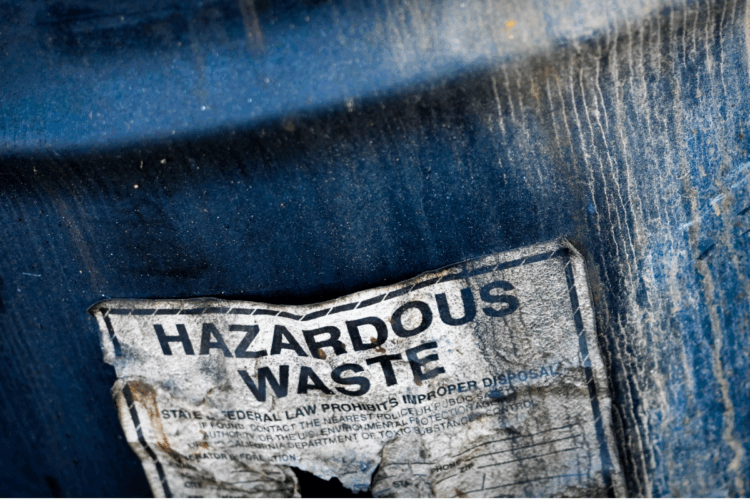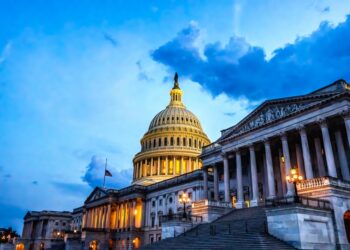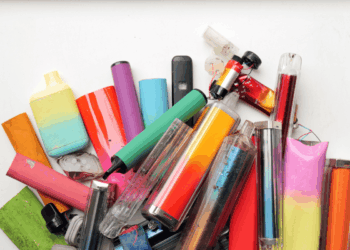Riding the ongoing recycling policy wave, Vermont recently enacted a program nearly a decade in the making that’s designed to put producers in charge of handling household hazardous materials.
Gov. Phil Scott signed the hazardous household waste (HHW) extended producer responsibility (EPR) bill into law June 12, making Vermont the first state in the nation to enact EPR for that category.
Supporters who worked on the bill said it required collaboration and creativity to overcome obstacles and enact EPR for such a varied group of products, and they hope their efforts will inspire and inform others to introduce similar bills.
Jen Holliday, director of public policy and communications for the Chittenden Solid Waste District (CSWD) and chair of the Vermont Product Stewardship Council, told Resource Recycling that the first version of the HHW EPR law was introduced in 2014. Vermont’s legislature operates on a biennium model, so this successful law was the fourth version to be introduced.
“Every time we introduced the bill, we had learned from our experience previously, had figured more things out, had adjusted, and it was definitely a progression of different bills,” she said. “H67 was very different than the first one.”
Threat to both environment and people
H67 is the state’s eighth EPR law – meaning Vermont has the most EPR laws of any state in the U.S. – according to a Product Stewardship Institute (PSI) press release.
Holliday, who is on the PSI board, and other supporters pushed for the bill because even though many local governments run HHW collection events, they’re infrequent and expensive. PSI estimated that an estimated 855 tons of HHW material was going to Vermont landfills annually due to lack of consumer access and education.
“These unsafe disposal practices contaminate the environment and threaten the safety of drinking water; when stored at home, HHW puts children and pets at risk for poisoning and can cause fires or release dangerous pollutants during flooding,” the PSI press release stated.
Learn more in person
To keep up to date on the latest nationwide policy developments, join us at the 2023 Resource Recycling Conference (August 14-16 in Orlando, Fla.). We’ve got top-level panels covering the evolution of deposit return systems, the intersection of plastics and EPR, what to expect on the legislative landscape in 2024, and more. Check out the full session lineup and register today.Holliday noted that in 2022, municipalities spent more than $2.2 million on disposal events, with some towns spending between $100 and $400 to manage a single carload. A state report added that’s a 50% or more increase in cost over previous years.
Suna Bayrakal, PSI’s director of policy and programs, worked on the legislation and said she thinks it will “hold the producers responsible for making sure the program is convenient enough.”
PSI has a long history of working with Vermont on EPR bills, including those for paint, electronics, pharmaceuticals, mercury lamps, mercury thermostats and batteries. For HHW, the advocacy group conducted research on similar Canadian programs and drew on past experiences working in Oregon on a bill that did not pass.
Holliday worked to compromise with all the involved stakeholders, she said, and her organization tried several different angles before succeeding.
“One of the ideas initially was that we don’t have enough convenience in the state of Vermont and we really wanted more permanent programs, so either the first or second version required the producers to have convenience standards that were set out in the bill of so many permanent facilities,” Holliday said.
However, analysis from PSI later revealed that the logistics of a permanent facility were tricky, because only about 30% of what would likely come in would actually be covered under the EPR program.
“How do you require producers to invest in infrastructure that 70% of the material coming in isn’t going to be applicable to them covering?” she said. “We got really caught up in that for probably a year and a half.”
In the end, the solution was to move convenience standards into the stewardship plan requirements, so the producers could decide how to handle it. In addition, several permanent municipal HHW programs had started in the meantime, reducing the need to set the requirement in policy, Holliday noted. There are now seven municipal solid waste management entities with permanent programs, the law noted.
Nonetheless, the legislation that did pass did not have full support from producers.
Mike Gruber, Household and Commercial Products Association executive vice president of government relations and public policy, said he did not support an EPR program. “There have been bumps along the way,” he said, “but we want to make sure the solid waste districts get the funding they need to do the job of managing this waste.”
He added that because the bill is the first of its kind, “there are a lot of unanswered questions.”
The team working to pass the bill also played with different funding models, including mirroring a long-running Vermont pesticide registry fee the state agriculture department charges to cover disposal of pesticides that are collected.
“We started researching a way that we could assess a similar registration fee on the producers of toxic products that are sold in the state and use that mechanism, so it wouldn’t have been truly an EPR model, just funding through the registration of their products,” Holliday said. “We tried that for a year at least in one of the bills and … I think the session ran out and we went back to square one the next year and we decided to scrap that idea.”
Bayrakal noted that equity language was also added to later iterations of the bill, calling for special attention to historically underserved communities and outreach that is culturally responsive.
Concerns about complexity
Gruber said the organization had been monitoring the legislation for some time. HCPA is not supportive of an EPR-style program, he said, and initially proposed a “simple fee that industry would pay to the state that in turn would be used to provide additional funding to solid waste districts.”
“That was fully rejected in favor of an EPR program, so we worked with the legislature to try and make sure that they heard our concerns about the complexity of earlier proposals,” Gruber said. “They listened to us and the initiative is a bit different now than it was earlier this year.”
Gruber said HCPA focused on streamlining and simplifying the program, to make it easy to get the smaller solid waste districts the funding they need. Earlier versions had “a lot of different decision making processes that had to be reviewed by advisory boards, and it seemed like a very confusing way of getting funding into these districts to do this work,” he said.
That’s a concern Gruber said he has for EPR bills across industries. As EPR bills crop up across the U.S., it seems that lawmakers are sometimes “trying to do these massive, very aggressive bills without knowing how it will work,” he said.
“These bills can get super complicated super fast and our concern is that states are overwhelming their regulators and overwhelming the industry,” he said. “At the end of day, in Vermont, we want to make sure that the solid waste districts have adequate funding and our opinion is that there should be relatively simple pathways to ensure that there are fees from industry that can be directed to those smaller organizations that know exactly what they’re doing.”
Success this session
Holliday said she thinks part of the reason for H67’s successful passage this year was the overall sea change. EPR in general, especially multi-product EPR for packaging, is starting to take hold in the U.S.
In addition, “this year we were more organized as a group than ever.”
Supporters created a one-page brief on what the bill was and why it was needed, and they gave it to legislators. It was something “quick and easy for them to digest,” Holliday said, because they recognized that EPR can be complicated to rapidly understand and vote on.
“I think it was very helpful because you educate certain committees, but other committees never hear the testimony, they don’t understand the issue, they need to get sort of a ‘tell me why this is important and a good thing,'” she said.
In addition, Holliday said she arranged to have several smaller solid waste districts testify, explaining how the household hazardous waste events they count on have gone up in cost “astronomically.”
“They told really compelling stories on why it was a real problem,” Holliday said.
Bayrakal said the passage was a testament to Holliday’s tenacity, “the unity of the group vision over time” and consistent legislator education efforts.
“That all contributed and … the costs are just going up so significantly that it’s becoming increasingly a significant issue for the local governments, too,” she said.
Details of the new law
H.67 creates a statewide HHW EPR program, managed and funded by manufacturers. Local governments can opt in to the program to get reimbursed for the costs of collection.
The law includes performance goals, annual reporting, education and outreach mandates, and the option to alter the stewardship plan as the program matures and producers learn more.
It covers any hazardous product that isn’t already collected as part of an EPR program, including adhesives, lubricants, degreasers, aerosols, mineral spirits, automotive chemicals, non-refillable propane cylinders, cleaning solutions and a number of other potentially harmful materials.
Pesticides and herbicides are covered under a separate program and therefore are excluded from H67.
The performance rate is calculated by taking the number of total participants at collection events and facilities in a program year and dividing it by the total number of households in the state, including seasonal households, the law states.
The performance goal is a minimum of 5% for the first year, after which the stewardship organization will propose performance goals.
If the performance goals aren’t met, the stewardship organization could be directed to do additional public education and outreach, additional collection events or additional hours of operation at collection sites.
Moving forward
If other states are considering similar laws, Holliday suggested reaching out to PSI for guidance and making sure there’s enough data to tell the story.
“What is your story and what is the data that shows and tells that story for why this is a problem?” she said.
Having a well-drafted bill prior to introduction is also vital, she added, so that way the committees don’t get bogged down. Having a one-page brief to hand committee members and other legislators is also a key to success, she said.
“Have a vision, have a real good, strong, clear bill before going into committee,” she said. “Get a champion legislator and sponsor and get it written with stakeholders.”
Bayrakal said it’s important to keep in mind that sometimes, such bills just take time and persistence is needed.
“Now that all the hard, smart efforts of Vermont have resulted in a passage of this law, hopefully it will make it easier for others,” she said. “We have seen interest in other states.”



























